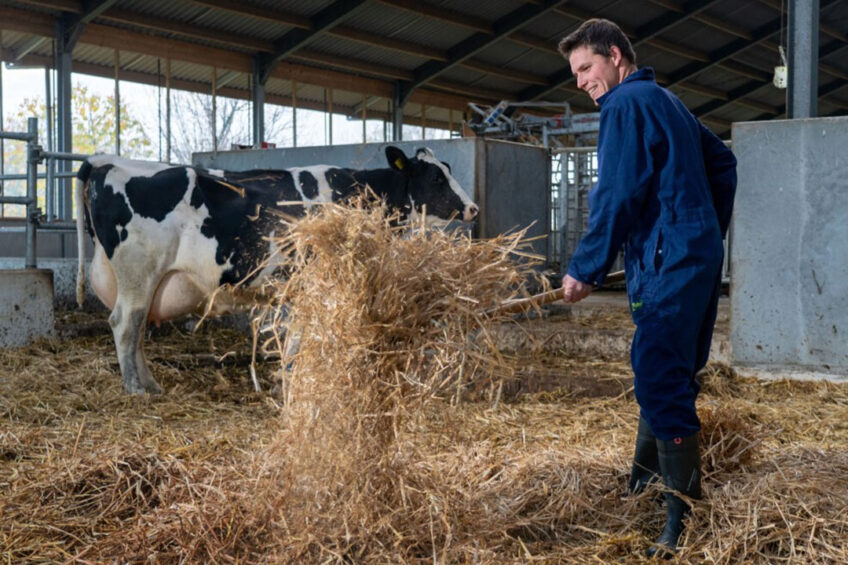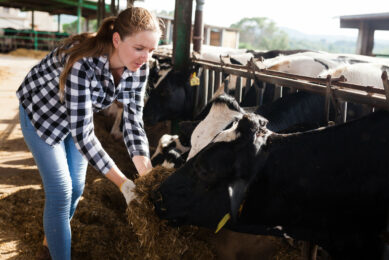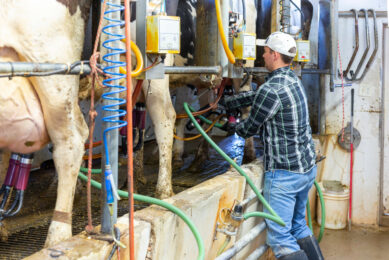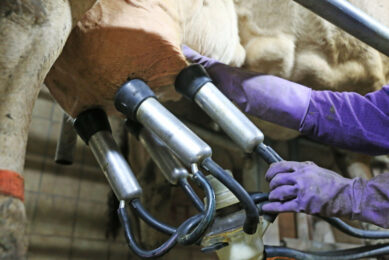5 key factors to improve labour efficiency on dairy farms

Farm labour represents one of the largest costs in the production system for the dairy sector and is increasingly becoming a key challenge facing milk producers.
Early analysis from a study by 2 business development groups in County Down, Northern Ireland, for the College of Agriculture, Food and Rural Enterprise (CAFRE) has found that there are some producers who are struggling to ensure the production model is socially sustainable and providing an appropriate work-life balance.
As farms have developed, a significant proportion of farmers have tried to do all the extra work, working up to 81 hours a week, which is difficult to maintain in the long-term and can lead to poor efficiency or burn-out.
Challenges facing dairy farmers
Other challenges facing producers include dealing with compact calving. It can bring improved fertility performance, a simplified heifer rearing enterprise and improved herd health protocols but at the same time it presents a seasonal and concentrated labour demand profile. Significant planning and preparation are required to manage the increased labour demand during calving.
While total hours worked on farm by family members and paid employees is important, an efficiency metric is required. Hours worked per cow per year takes the total annual hours and divides it by the herd size. Initial data suggested larger herds tend to work less time per individual cow, gaining efficiencies with time dilution on some tasks.
However, the survey found a huge variation in hours worked per cow across both business development groups ranging from 22.5 hours/cow/year to a significant 55.7 hours/cow/year. This is due to milking routines, facilities and work organisation.
Total annual farm labour of those surveyed ranged from 4,200 hours to 13,040 while herd sizes were between 86 and 555 cows.
5 key factors to improve labour efficiency this winter
The ongoing study, supported by the Department of Agriculture, Environment and Rural Affairs, has found:
 Outsourcing work – One of the key features of efficient dairy farms is the farmer’s ability to organise and delegate tasks. Breeding is a key area especially if it is condensed into a limited number of weeks. Outsourcing this work brings about many benefits, including reducing farm labour demand for heat detection and breeding to improve fertility performance for the overall herd.
Outsourcing work – One of the key features of efficient dairy farms is the farmer’s ability to organise and delegate tasks. Breeding is a key area especially if it is condensed into a limited number of weeks. Outsourcing this work brings about many benefits, including reducing farm labour demand for heat detection and breeding to improve fertility performance for the overall herd.
 Good communication – the ability to communicate between all people working on the farm is critical when it comes to achieving an efficient dairy farm. When it comes to making most efficient use of the labour on a dairy farm, good organisational practice and communication techniques like white boards, WhatsApp or farm maps are required to ensure the overall enterprise runs smoothly. Building good practise and standard operating procedures is crucial for a dairy farm.
Good communication – the ability to communicate between all people working on the farm is critical when it comes to achieving an efficient dairy farm. When it comes to making most efficient use of the labour on a dairy farm, good organisational practice and communication techniques like white boards, WhatsApp or farm maps are required to ensure the overall enterprise runs smoothly. Building good practise and standard operating procedures is crucial for a dairy farm.
 Capital investment – the milking process can account for 25-50% of hours worked on a farm depending on facilities. This can change dramatically when herds expand or move to 3 times milking per day. Changing the milking facilities on your farm may be a ‘once in a generation’ decision. Selecting the most cost-effective and labour-efficient and simply operated system is critical. The investment must meet labour saving criteria – will the parlour allocate concentrate automatically? Is cow-flow at parlour entry and exit optimised?
Capital investment – the milking process can account for 25-50% of hours worked on a farm depending on facilities. This can change dramatically when herds expand or move to 3 times milking per day. Changing the milking facilities on your farm may be a ‘once in a generation’ decision. Selecting the most cost-effective and labour-efficient and simply operated system is critical. The investment must meet labour saving criteria – will the parlour allocate concentrate automatically? Is cow-flow at parlour entry and exit optimised?
 Capitalise on technology – From survey data, heat detection equipment appears to provide significant labour savings. This equipment reduces labour demand for heat detection while also offering early detection of animal health issues. Fully utilised, well-designed and managed correctly, these investments can provide significant labour savings.
Capitalise on technology – From survey data, heat detection equipment appears to provide significant labour savings. This equipment reduces labour demand for heat detection while also offering early detection of animal health issues. Fully utilised, well-designed and managed correctly, these investments can provide significant labour savings.
 Building team morale – While pay is important in terms of attracting and retaining good staff, some farmers surveyed noted that it was not always the most important aspect of the job. Developing a sense that employees were trusted and who felt their opinions were valued are important as well as having good communication and fair and flexible working hours.
Building team morale – While pay is important in terms of attracting and retaining good staff, some farmers surveyed noted that it was not always the most important aspect of the job. Developing a sense that employees were trusted and who felt their opinions were valued are important as well as having good communication and fair and flexible working hours.
Join 13,000+ subscribers
Subscribe to our newsletter to stay updated about all the need-to-know content in the dairy sector, two times a week.










